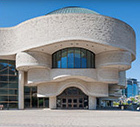The Canadian History Hall: big project, tight deadline
August 21, 2014
The Canadian History Hall will be the signature permanent gallery of the new Canadian Museum of History. It will occupy approximately 4,000 square metres, or about half the Museum’s permanent exhibition space. The Hall’s purpose is equally monumental: to tell the story of Canada and its people from the dawn of human habitation to the present day. Chantal Amyot is the project’s director, and David Morrison is leading the development of the exhibition’s content.
Both say the hall will feature an eclectic and engaging collection of stories — presented chronologically — about the diverse people, events and experiences that have shaped our country. Through artifacts, audio-visuals, interactive modules, documents, artwork, eyewitness accounts and multiple perspectives, visitors will be able to forge modern-day connections with Canada’s history in new and exciting ways.
Amyot says that developing the exhibition is a colossal task, made even more challenging by a tight deadline. The gallery is scheduled to open three years from now, as a focal point in the national celebration of the 150th anniversary of Confederation.
“This is certainly doable,” says Morrison, “but it will be tight. We can’t waste any time.” Over the past 18 months, Morrison and his 12-member team of curators and researchers have conducted a thorough survey of Canadian history, looking for potential stories. The initial list was almost overwhelming.
“Some people talk about history as if it were some dry and narrow list of prime ministers,” says Morrison. “But it’s hard to think of a word that is more encompassing than ‘history’. It includes literally everything that has happened in Canada up until now. The difficulty is picking the stories that are nationally important, with which we can tell the history of Canada in a finite space.”
Morrison and his team, along with creative development specialists, are now working hard to winnow down the list (with help from advisory committees of outside experts). “We have to analyze and prioritize and make sense of it all,” he says. Every story has to be judged on its own merits, but also considered within the context of the entire exhibition and its overall storyline, and according to a set of guiding principles. It’s an incredibly complex and time-consuming process.
In the meantime, Amyot is working with the professionals who will define the visitor experience and redesign the exhibition space. Among them is Douglas Cardinal, the renowned Aboriginal architect who designed the Museum’s iconic building. Their challenges include the dismantling and renewal of two entire floors of gallery space, and the development of leading-edge design that will add depth and “pizzazz” to create a unique exhibition experience. Both challenges are formidable — two more reasons why that distant deadline seems not so far away.